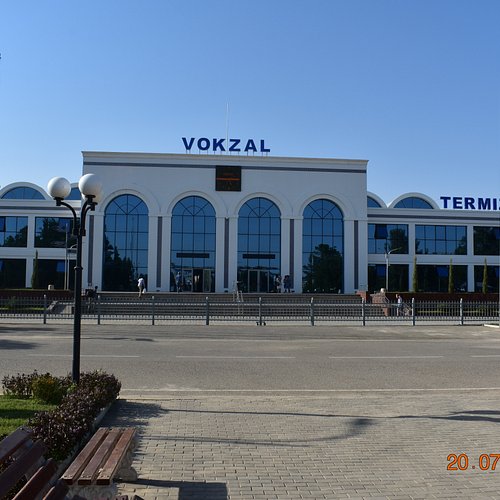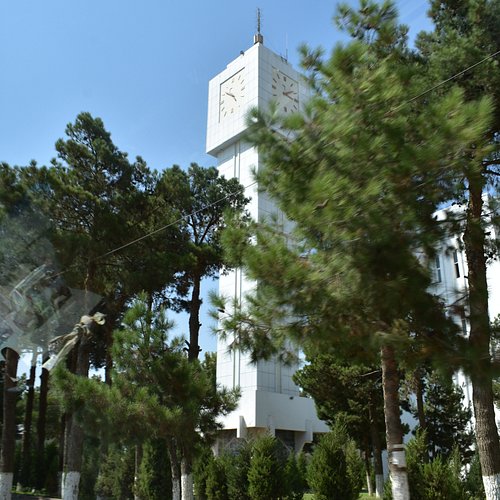6 Architectural Buildings in Termiz That You Shouldn't Miss
Discover the best top things to do in Termiz, Uzbekistan including Archeological Museum, Train Station, Clock Tower, Termez Mosque, Al Khakim At Termizi Mausoleum, Church of Aleksandr Nevskiy.
Restaurants in Termiz
1. Archeological Museum
Overall Ratings
4.0 based on 18 reviews
Reviewed By andrewmU2655XD
This museum is a short walk from the Train Station. This was the last attraction that we visited on our day tip to Termez, and it was a great experience. The two story building has the main exhibits on the 2nd floor, but also an interesting section on the 1st floor. The exhibits on the first floor were from many eras but focused on some of the more important archaeological discoveries in the region. Of particular interest here is the bath tub exhibit and the pottery. There was a special exhibit dedicated to Japanese archaeologist, Kyudzo Kato, who died in 2016. He is known for his work at the Fayaz tepa and Kara tepa sites. In this area, was a copy of the famous Buddha sculpture with monks on either side, and corinthian columns. This sculpture was found at Fayaz tepa. A model of the Fayaz Tepa site was also in this section. The upstairs exhibits were divided into nine halls. These halls traced the history of the region through the stone age to the 20th century. The exhibits were well organised, and most had English translations. We were impressed with the Macedonian era exhibits, which included a bust of Alexander the Great. The Kushan and Sassanid periods were also well covered. We thought the displays of Greek influenced sculptures and other items was well presented. A few exhibits were related to Indian culture, and the importance of Termez on the Silk Road, including a map showing the caravan routes. A great exhibit here were ancient clay urns for holding mercury, which indicated how far advanced medicine was in this area. There is a special section dedicated to Amir Timur, who re-developed the city after it had been destroyed by the Mongols in 1220. We found the 16th-20th century exhibits, of Russian samovars, urns and lamps to be very good. After viewing the upstairs exhibits, we returned downstairs and were allowed to view the special exhibit room, which has to be requested. This was the best area of the museum, as there were ancient coins and beautiful jewelry on display. A few old bank notes, daggers and bayonets were also good displays. We were glad to have visited the museum, as it gave us a better appreciation for the Fayaz Tepa, Kara Tepa and "old city" sites which we had visited during the day. An additional camera fee is required on entry but it is worth it. We thought this was an excellent museum. After visiting the museum, walk to the Central Park directly opposite, where the monument to Alpamysh and the Weeping Mother can be viewed.
2. Train Station
3. Clock Tower
4. Termez Mosque
5. Al Khakim At Termizi Mausoleum
Overall Ratings
4.0 based on 3 reviews
Reviewed By andrewmU2655XD
This complex is located 12 km north west of the town center. We visited this site as part of a tour, but locals take a bus or taxi from town. There are shops which sell f&b and souvenirs to the left of the entrance. Once you have walked through the gates, the beautifully manicured garden will take your breath away. If you are a garden enthusiast this will be a great visit, as there are many exotic flowers and plants that make up the complex. We had just viewed the nearby Fayaz Tepa site which was hot and arid, so this was a welcome change. The Khanaka, which was built between 1405-1409, provided accommodation for visitors, and is the first structure seen to the left of the path. The building had a blue tile decorated iwan, and on either side are two arched windows, which also have decorations above them. The guldastas at either end, have lantern designs near to the top and blue caps. A camel sculpture is outside the building and many persons were taking photos here. We continued along the path to the al-Hakim at-Tirmiz mausoleum which had many brick graves to the right. These graves are for periods 12th-19th century. Imam al-Hakim lived in the 10th century, and was buried at this site. A brick mausoleum was built and decorated in the 11th century. The structure may not have survived the Mongol invasion in 1220, as it was rebuilt in 1390 by Amir Timur. His grandson Khalil Sultan did extensive redecorating to the tomb. The golden decorations of the inner tomb and dome area, reminded us of the Gur-e-Amir tomb in Samarkand, which was also decorated in the Timurid era. There were many bank note donations at the base of the coffin. We thought that the best area of the tomb was the mihrab, which was a mix of brick and varying shades of brown decorations. After viewing the mausoleum, we walked on the path to the rear of the building admiring the many species of plants and trees. In this area there are underground cells (chillahon) which persons would use for deep meditation. The final building is the Museum of History of Termez and Heritage of Termezids. The complex was built on a site which was occupied by the Kushan Empire between the 1st - 3rd century. Many of the items on display were found during the renovation of the buildings. These items included coins, pottery, decorated column sections, oil lamps and a few ancient weapon from later periods. It is a small museum, but provides a better understanding of the nearby Buddhist sites. The most important section of the complex was at the rear which offered a view of the old and restored walls of "Old Termez". This was the site that Genghis Khan decimated in 1220 on his way to Urgench. It is also thought to be the site of Demetris, which Alexander named the city after conquering it in 329 BC. The area is now known as "no mans land", and is surrounded by barbed wire and inaccessible. A map and storyboard show the city as it might have been. Photos of the old city wall can be taken through the fence.






